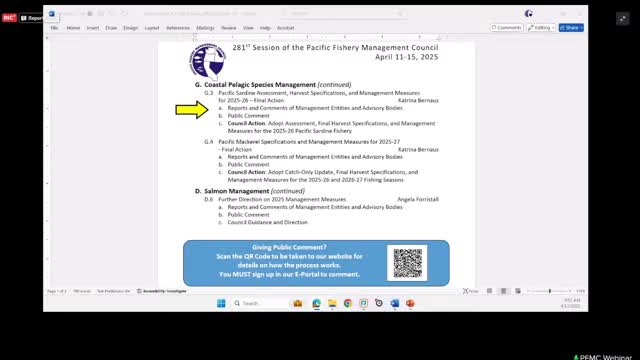CPS management team sets Pacific sardine catch limits amid declining biomass estimates
April 13, 2025 | Fishery Management Council, Pacific, Governor's Office - Boards & Commissions, Executive, Washington
This article was created by AI summarizing key points discussed. AI makes mistakes, so for full details and context, please refer to the video of the full meeting. Please report any errors so we can fix them. Report an error »

The April 13, 2025, meeting of the Pacific Fishery Management Council (PFMC) focused on the assessment and management of the northern subpopulation of Pacific sardine. The session began with discussions regarding the recent biomass estimates, which indicated a total of approximately 77,000 metric tons as observed by the Assessment Team Model (ATM) and around 53,000 metric tons from an aerial survey. These figures were referenced in relation to the assessment update report, specifically table A.2, which details model results.
The Scientific and Statistical Committee (SSC) acknowledged the uncertainty surrounding biomass estimates and age structure, particularly noting the influence of Japanese sardine on the current assessments. The SSC's discussions were primarily centered on the general fit of various abundance indices rather than a detailed examination of specific tables.
Greg Krzykowski from the Coastal Pelagic Species Management Team (CPSMT) presented the team's report on the Pacific sardine assessment and management measures. The CPSMT reviewed the documents related to the northern subpopulation and recommended an overfishing limit (OFL) of 8,645 metric tons for the 2025-2026 fishing year, based on an age-1-plus biomass estimate of 30,158 metric tons as of July 1, 2025. Due to the biomass being below the minimum stock size threshold of 50,000 metric tons, the council decided to close the primary directed fishery for the upcoming year. However, this closure does not restrict exempt fishing permits or incidental catches.
The CPSMT proposed an annual catch limit (ACL) of 2,200 metric tons, aligning with the revised sardine rebuilding plan adopted in November 2024. The team also recommended a precautionary P-star value of 0.45 to mitigate the risk of exceeding the OFL. The recommended annual catch target (ACT) was set at 2,000 metric tons, which would trigger accountability measures if the ACL is approached.
The meeting concluded with the CPSMT emphasizing the importance of monitoring landings to ensure compliance with the established limits. The council's decisions reflect a commitment to sustainable management practices while allowing for some flexibility in incidental catches across various fisheries. The next steps include awaiting a decision from NOAA Fisheries on the rebuilding plan by June 1, 2025.
The Scientific and Statistical Committee (SSC) acknowledged the uncertainty surrounding biomass estimates and age structure, particularly noting the influence of Japanese sardine on the current assessments. The SSC's discussions were primarily centered on the general fit of various abundance indices rather than a detailed examination of specific tables.
Greg Krzykowski from the Coastal Pelagic Species Management Team (CPSMT) presented the team's report on the Pacific sardine assessment and management measures. The CPSMT reviewed the documents related to the northern subpopulation and recommended an overfishing limit (OFL) of 8,645 metric tons for the 2025-2026 fishing year, based on an age-1-plus biomass estimate of 30,158 metric tons as of July 1, 2025. Due to the biomass being below the minimum stock size threshold of 50,000 metric tons, the council decided to close the primary directed fishery for the upcoming year. However, this closure does not restrict exempt fishing permits or incidental catches.
The CPSMT proposed an annual catch limit (ACL) of 2,200 metric tons, aligning with the revised sardine rebuilding plan adopted in November 2024. The team also recommended a precautionary P-star value of 0.45 to mitigate the risk of exceeding the OFL. The recommended annual catch target (ACT) was set at 2,000 metric tons, which would trigger accountability measures if the ACL is approached.
The meeting concluded with the CPSMT emphasizing the importance of monitoring landings to ensure compliance with the established limits. The council's decisions reflect a commitment to sustainable management practices while allowing for some flexibility in incidental catches across various fisheries. The next steps include awaiting a decision from NOAA Fisheries on the rebuilding plan by June 1, 2025.
View full meeting
This article is based on a recent meeting—watch the full video and explore the complete transcript for deeper insights into the discussion.
View full meeting
